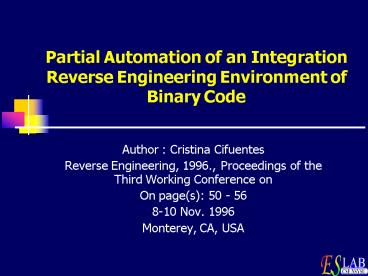Partial Automation of an Integration Reverse Engineering Environment of Binary Code - PowerPoint PPT Presentation
1 / 15
Title:
Partial Automation of an Integration Reverse Engineering Environment of Binary Code
Description:
Idiom analyzer. Control flow graph generator. UBM/UDM. Loader ... An idiom is a sequence o instructions that has a special meaning that can't be ... – PowerPoint PPT presentation
Number of Views:161
Avg rating:3.0/5.0
Title: Partial Automation of an Integration Reverse Engineering Environment of Binary Code
1
Partial Automation of an Integration Reverse
Engineering Environment of Binary Code
- Author Cristina Cifuentes
- Reverse Engineering, 1996., Proceedings of the
Third Working Conference on - On page(s) 50 - 56
- 8-10 Nov. 1996
- Monterey, CA, USA
2
Introduction
- Whats the problem?
- Investment made on software when newer machine is
available. - Two points of view for migration of software
- From a commercial view
- Software needs to be available on the new machine
at the same time. - From a software developers point of view
- Software developed in-house is an investment and
asset to an organization. - Software migration is not a trivial problem!!
3
Four approaches to solve this problem
- Use a native compiler to compile the source code
for the new platform. - Emulation of old machines instructions using
micro-code hardware in new machine. - Emulation of old machines instructions in
software in new machine. - Binary translation
4
Problems
- On using a native compiler to compile the source
code - Compilation requires access to all source code,
which may not be feasible. - On Emulation of old machines instructions using
micro-code hardware - Its requires special micro-programmable
hardware, which is not include in todays RISC
machine. - On Emulation of old machines instructions in
software - Software emulation is easy to implement but slow.
5
Structure of a Binary Translator and a De-compiler
- Front-end
- The front-end is a machine-dependent module that
loads the source binary program, disassembles it,
and translates it into an intermediate
representation. - Middle-end
- Performs the code analysis for the translation,
and performs optimizations on the code - Back-end
- It is a target machine-dependent module that
generates code for the target machine
6
Integrated Reverse Engineering Environment for
Binary Code
7
A Compilers Structure
8
An Integrated Reverse Engineering Environment for
Binary Code
- Loader
- Disassembler
- Signature generator
- Prototype generator
- New Jersey machine-code toolkit (NJMC)
- Idiom analyzer
- Control flow graph generator
- UBM/UDM
9
Loader
- Just like the operating system loader.
- Read the binary file by decoding the binary-file
format used to store the program, and determine
the files structure (instructions, tables,
symbol tables).
10
Disassembler
- Parses the binary image of the program and
translates it to assembler or some equivalent
representation. - It parsed starting at the entry point and
following all paths from this point. - Analysis address of indexed and indirect jumps or
calls
11
Idiom analyzer
- Detect idioms and translates the sequence of
instructions into intermediate instructions. - An idiom is a sequence o instructions that has a
special meaning that can't be derived from
semantics of the individual instructions alone. - Examples
- ARM
- bl foo
- X86
- Sub ax,immedLo
- Sbb ax,immedHi
- sub dxax, immedHiimmedLo
12
Control flow graph generator
- Constructs a control flow graph for each
subroutine of the program. - The control flow graph is part of the
intermediate representation of any reverse
engineering tool that deals with binary code.
13
Second Generation Tools
- Signature generator
- Automatically determines library signatures
- Prototype generator
- Automatically determines the types of the formal
arguments of library subroutines, and the type of
the return value for functions. - New Jersey machine-code toolkit (NJMC)
- Facilitate the decoding of machine instructions
by provide a specification language to define
machine instructions.
14
UBM/UDM
- Universal binary-translation machine
- Generates binary programs for target machine
- Universal decompilation machine
- Generates high-level language (like C).
15
Conclusions
- This paper presents an integrated environment for
the reverse engineering of binary programs. - Such environment is suitable for the development
of disassemblers, binary translators and
decompilers. - Make retargetable techniques essential in order
to develop such tools for a variety of machines
rather than for one specific machine.































